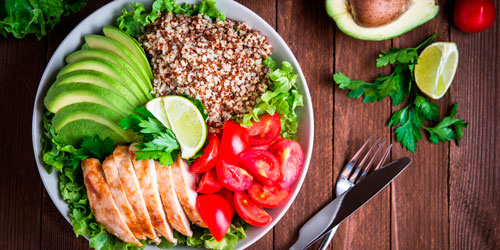In order to achieve favorable results in Pilates classes and maintain a healthy life, we must always combine the practice of exercises with good nutrition.
Our body needs vitamins, complete and balanced nutrients for the maintenance of functions and supply of energy to perform the activities of our day-to-day and also carry out Pilates classes.
With the practice of physical activities, including Pilates, we must be concerned with good nutrition because this, in addition to improving our performance, helps us achieve better results.
Whenever we do Pilates classes, whether they are low, moderate or high intensity, we have an increase in the daily needs of certain nutrients such as carbohydrates, proteins, vitamins, minerals and also calories and water.
We don’t always know which foods are best for Pilates classes. The correct choice of foods that we consume before and after training are essential to keep our bodily functions stable during activity and enhance the effects of Pilates in our lives.
Foods to Eat Before Pilates Classes
Before Pilates classes, we always have to think about performing a good diet using light foods to avoid gastrointestinal problems, such as reflux and abdominal pain, since most exercises require the work of the abdominal muscles and also keep us upside down. .
So, nothing to do that super meal before going to your class!
A good food tip that we can take to avoid suffering from these discomforts are fruits, fruit juice, vitamins, natural yogurts, dried fruits, oil fruits such as cashew nuts, Pará and almonds, tapioca, among other easily digestible foods.
Regarding the schedule, the ideal is to always consume this good food from half an hour to 1 hour before the Pilates classes.
We cannot forget about water consumption! If our hydration is adequate before Pilates, our performance will be better.
Types of Carbohydrates to Eat Before Pilates Classes
Carbohydrates are nutrients that provide energy for us to perform all of our day-to-day activities, including Pilates.
The consumption of carbohydrates before Pilates classes is essential, regardless of the objective (weight loss, definition, etc.), that is, by performing a good diet, we will have good results in our exercises.
Therefore, before Pilates training, the best type of food that we should eat are those that have a good source of low glycemic index carbohydrate.
The glycemic index is an indicator that determines the speed at which glucose, sugar, increases in our blood after consuming a carbohydrate source food.
When we say that a food is low in glycemic index, we want to report that glucose will gradually increase in our blood and decrease in the same proportion.
The importance of consuming this good diet is due to the positive impacts it will have on our bloodstream, avoiding high spikes in blood sugar, with sudden drops as well.
These sudden falls can cause dizziness, fatigue, hypoglycemia and headache.
The foods indicated to be eaten before Pilates classes and low glycemic index, are:
Fruits: fresh plum, cherry, apple, pear, melon, apricot, peach
Dairy products: light yogurt, plain yogurt, oat bran milk, skim milk
Oil fruits: nuts, pistachios, chestnuts, almonds
Cereals and tubers: oats, sweet potatoes, rye
Low-carbohydrate diets may be related to low performance in physical activities, including Pilates, as they increase the tendency to fatigue.
For these reasons, carbohydrate intake planning should be tailored to individual needs and tolerances.
Foods to Avoid Before Pilates Classes
Before classes, we should avoid fatty foods, sources of fiber, large meals and excess fluids as these foods cause a slower digestion, that is, they stay in our stomach for longer, bringing us gastrointestinal discomfort during the execution of the Pilates movements .
We must remember that no type of food should be eaten in excess, especially at times very close to the beginning of the class. The exercises are performed in different positions and some of them can cause discomfort.
And the Nutritionist, how can you help me?
The nutritionist is the qualified professional who can help you develop a plan to have a good diet, with adequate carbohydrates and nutrients, balanced and individualized, according to your preferences and eating habits.
It will help you improve your performance during Pilates classes or any other physical activity, help you achieve your goals whether it be weight loss, dietary reeducation, hypertrophy, among others.
Only the professional nutritionist can give you tips on a good diet to be consumed before, during, and after Pilates classes, always respecting your individuality.
Discover more from Pilates All Ages
Subscribe to get the latest posts sent to your email.
